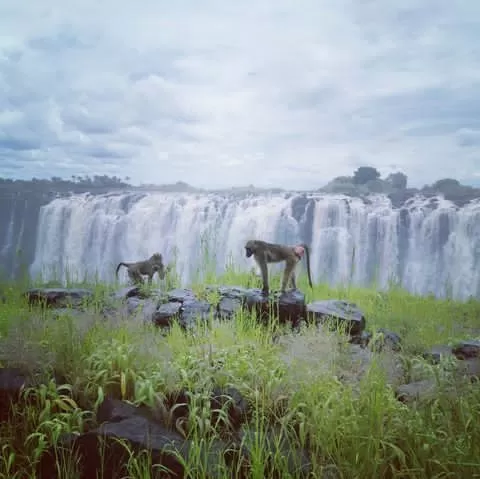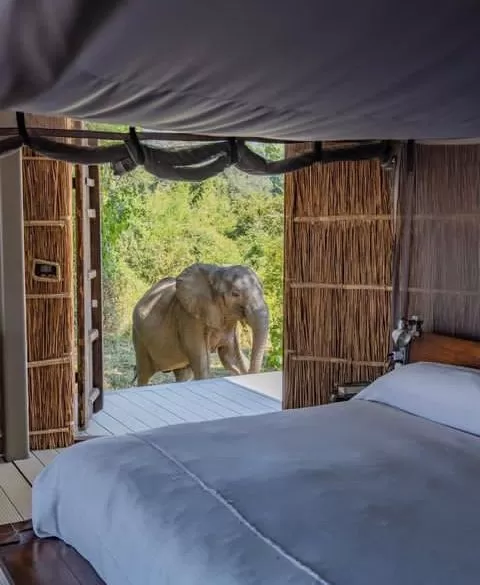Victoria Falls presents a spectacular sight of awe-inspiring beauty and grandeur on the Zambezi River, forming the border between Zambia and Zimbabwe.
The water falls was described by the Kololo tribe living in the area in the 1800s as ‘Mosi-oa-Tunya’ – ‘The Smoke that Thunders’. In more modern terms Victoria Falls is known as the greatest curtain of falling water in the world.
Victoria Falls is a waterfall on the Zambezi River in southern Africa, which provides habitat for several unique species of plants and animals. The water fall is located on the border between Zambia and Zimbabwe.
The water fall which was named after the Queen of England between the year 1819 to 1901, is one of the seven natural wonders of the world. It has a width of 1688 metres and a height of 108 metres and experience rainfall all day.
History of the Victoria Falls
In the year 1851, Livingstone first heard of the great waterfall, but it was only in 1855 that he set out to visit it. He spent the night on Kalai Island a few kilometers upstream of the Falls, having come down river by foot, and the next morning set off in a small canoe to approach the thundering smoke. He landed on the biggest island on the lip of the falls, now called Livingstone Island and from there obtained his first view of the Falls.
” Creeping with awe to the verge, I peered down into a large rent which had been made from bank to bank of the broad Zambezi, and saw that a stream of a thousand yards broad leaped down a hundred feet and then became suddenly compressed into a space of fifteen to twenty yards….the most wonderful sight I had witnessed in Africa.”
Of the surrounding area he wrote: “No one can imagine the beauty of the view from anything witnessed in England. It had never been seen before by European eyes, but scenes so lovely must have been gazed upon by angels in their flight” (Livingstone 1857).
It is thought that earth movement in an earlier geological period diverted the south-easterly flowing upper Zambezi River to a general easterly direction and so initiated the development of a waterfall in an area occupied by a massive bed of basalt which is about 305 m thick.
The basalt, through which the Zambezi runs for 209 kms in the Livingstone area is characterized by very marked joints or cracks, which may have developed as the molten lava cooled. One dominant series of joints running in an east-west direction is associated with zones of soft material within the basalt.
Since the Zambezi is flowing due south in the Livingstone area, these softer materials are very easily eroded to form the great east-west gorges. Upstream retreat of the Falls is due to a second major series of joints running north-south.
Gradual erosion of small joints that run north-south caused the river to be concentrated into a narrow fissure and the broad fall line was abandoned. Once this happened, it was only a question of time before the narrow gorges cut back into another transverse fracture zone of soft material.
This gouging out of the soft zone again established a broad fall. This process has been repeated over many years and the zigzag gorges represent seven previous lines of waterfalls.
The Devil’s Cataract, on the Zimbabwe side, which is lower than the rest of the present falls shows how the force of water is starting to cut back along such a line of weakness. It will probably erode its way back to another east-west joint where a future line of the waterfall will eventually become established.
Why is Victoria Falls so special?

Victoria falls offers tourists with a great experience of adrenaline adventure in terms cliff jumping, sky diving, bungee jumping,white water rafting just to mention a few.
There are, however, a couple of popular activities that are limited to the Zambian side of the falls, the first of which is a trip to Livingstone Island. Livingstone Island sits on the lip of Victoria Falls and is the spot where Dr David Livingsone first laid eyes on the falls – an experience he famously described as “scenes so lovely must have been gazed upon by angels in their flight”.
The view from the island is fantastic, but to really live life on the edge – take a dip in the Devil’s Pool! Leaping into the river at the top of one of the world’s most powerful waterfalls might sound like a crazy idea, however, swimmers are prevented from tumbling over the edge by a low rocky ledge called the Devil’s Armchair. Just make sure you follow the rules and go with a registered guide during dry season. Once again, the Devil’s Pool is only accessible from the Zambian side of the falls.
Near the Victoria Falls around the dry season, there is couple of wildlife animals like monkeys, buffalo, elephants that one can chance on as side attraction to their adventure.
What is the best time to visit the Victoria Falls?
Different times of the year will provide completely different experiences of the Falls region. Peak flood season is around March and April when the full power of the Falls can be experienced in all its glory. Due to the masses of spray rising from the fallen water, the full width of the Falls cannot be seen on foot.
The aerial view at this time is spectacular with clouds of spray rising high into the sky. As the floods abate the view of the Falls gets better and better through the year, but at it’s lowest, around November and December the Falls become little rivulets running over the edge and in some places along the 1,7km width, no water falls at all.
The delight of visiting the Falls in this season is the view of the impressive cliffs that form the Falls wall, and the magnitude of the abyss can be fully appreciated. Sobek and Safari Par Excellence do trips by raft to the base of the Falls in low season called ‘the float of angels”.
Getting to the Victoria Falls
The Falls can be approached from the town of Livingstone by traveling south on Mosi-oa-Tunya Road for some 11 kilometers. Just before the border, there is a turning to the right which leads to a parking area. Walks all around the Falls are accessible from this point.
If approaching from Zimbabwe, cross the border at the town of Victoria Falls and watch for the left turning just after the Zambian customs post.
Entry fees to the Victoria Falls
The entry cost for touring the location is categorized into the following;
- International visitors $30
- SADC visitors $20
- Zimbabwean citizens $7
- Lunar tours (all visitors) $40
- Children below age 6 pay 50% of the normal entry fee.
Accommodations near Victoria Falls

When it comes to selection of where to stay while in Zimbabwe for your adventure at the Victoria Falls, there are lots of hotels and lodge ranging from luxury to budget to suit individual preference.
Most travellers, however, choose to stay further upstream a bit away from the buzz surrounding the Falls. Luxurious lodges sit tucked into the trees on the bank of the Zambezi River, offering a peaceful retreat after an activity-filled day at the Falls.
There are many guest houses and hotels but some of the popular ones you can enjoy the comfort of your home includes the follow:
Shearwater’s Explorers Village
Thank you for reading this article.
Related articles
The Beautiful Twin Waterfall in Ghana – Boti Falls
Picture Gallery Of The Beautiful Aburi Garden
The Most Visited And Best Natural Lake In Ghana
Best Hikes From The Shai Hills Resource Reserve
Travel Guide To Tanzania And Top Things To Do
Meet The Beautiful Tanzania People From The Various Tribes
Things To Know About Nigeria Culture

